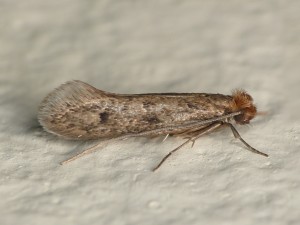Winter warning on moths with expensive tastes
24/01/2018
A NATIONAL trade body is urging people with a taste in expensive fashions to be vigilant to a pest which can create a costly riches to rags wardrobe malfunction.
According to the British Pest Control Association (BPCA), this is the time of year adult moths seek out suitable places for their larvae to feed – and firmly on the radar are costly cashmeres, wools and other materials of natural animal origin.
Infestations can leave clothes, as well as other materials including rugs, carpets, upholstery and blankets, riddled with holes and sometimes beyond economical repair.
Dee Ward-Thompson, BPCA technical manager, said: “In winter, adult moths search for suitable egg laying surfaces close to or on the food source of their larvae.
“This food source will contain fibres of natural animal origin such as wool, including clothes, rugs or carpets, and even museum artefacts.
“Larvae then feed on the material, creating holes throughout.”
According to BPCA, there are several species of clothes moths, all characterised by folding their wings tent-wise along their backs.
The most numerous species in the UK is the adult Common Clothes Moth, which is 6mm to 7mm long with pale, plain golden-buff wings fringed with hair.
Less common is the Case-Bearing Clothes Moth, which is duller and has three dark brown spots on each of its wings.
To reduce the likelihood of either infesting a property, BPCA says good hygiene is essential, with the use of a vacuum cleaner to remove larvae and their cases significantly reducing occurrences or problem outbreaks.
Ms Ward-Thompson added: “Signs of a potential infestation can include sightings of adult moths, small holes appearing in materials and the appearance of Frass, which is a smooth, lined tunnel weaved by the larvae, which consists of silk and excreta mixed together.
“To prevent damage taking hold, the presence of flying or resting adult moths should be investigated and items of natural animal origin checked regularly so that any issues can be found and treated promptly.
“Ultimately clothes moths can become destructive and professional input should be sought to ensure treatment plans are both safe and effective.
“Where an infestation is found, depending on the circumstances, BPCA members will usually advise a thorough vacuum of the affected area and the property throughout.
“If necessary, they will use a highly targeted, specialist insecticide to control the infestation, followed up by monitoring with pheromone traps to detect how successful the treatment was.”
The BPCA website contains advice on clothes moths along with a search tool to find professional controllers in your area. Visit www.bpca.org.uk
BPCA also provides further information relating to clothes moths in its A to Z of pest advice, available to view at https://bpca.org.uk/a-z-of-pest-advice/clothes-moth-control–get-rid-of-clothes-moths–bpca-a-z-of-pests/189171




